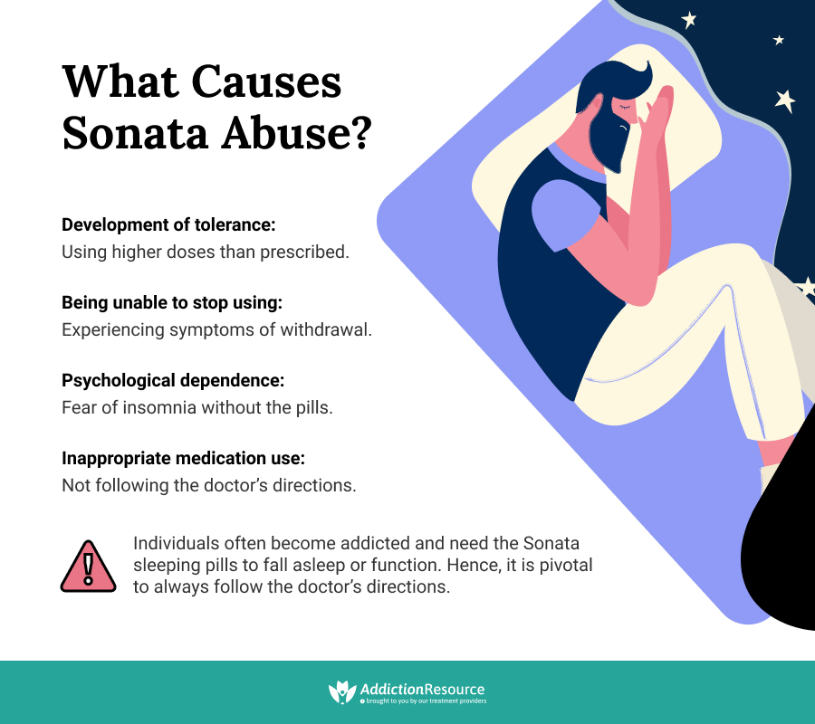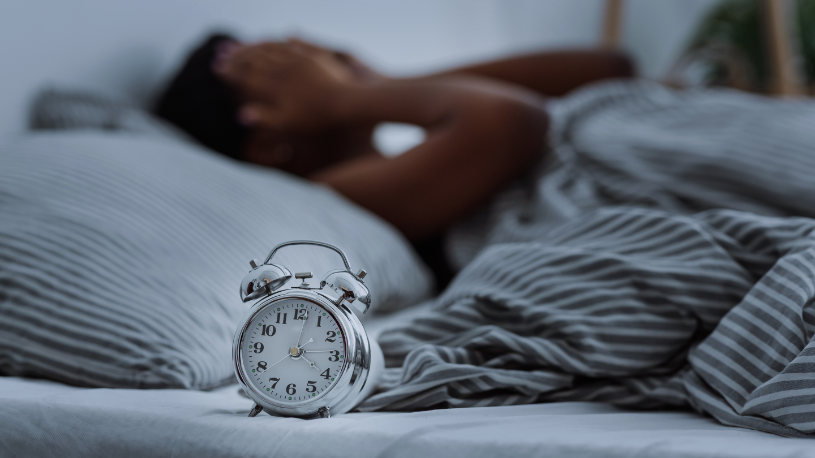
Insomnia, which refers to the presence of long sleep latency, frequent nocturnal awakenings, prolonged periods of wakefulness, or frequent nocturnal arousals is a commonly reported problem worldwide, with prevalence rates ranging from 33-45%. The sequelae of insomnia can have grave consequences on the physical, social, and emotional health and wellbeing of individuals. As a result, great efforts have been made to develop new novel agents for the treatment of insomnia. Zaleplon(Sonata) is one such agent, belonging to a group of sleeping pills, new, novel, non-benzodiazepine sedative-hypnotics known as “Z compounds” or “Z-drugs”. The Sonata sleeping pill, along with its congeners Imovane (Zopiclone) and Ambien (Zolpidem), were originally developed and promoted as having less potential for dependence and abuse, as well as fewer second-day side effects.
Table Of Contents:
However, clinical experience has shown that the development of tolerance, followed by Sonata abuse and Sonata addiction can be expected, especially with high doses and prolonged use. This is particularly concerning, as The United States Centers for Disease Control and Prevention reports an increase in the number of prescriptions for sleep aids in the past two decades. Therefore, due to the pertinence of this topic, this article will endeavor to briefly describe and review information regarding Zaleplon’s mechanism of action, correct dosing and administration, various Zaleplon side effects, and contraindications, as well as abuse, addiction, and its successful treatment.

More About Depressants:
What is Sonata?
Generic Sonata or Zaleplon, as mentioned above, belongs to a novel group of drugs known as “Z-drugs” that appeared on the pharmaceutical market during the 1980s. Zaleplon is a hypnotic or sleep agent that is not related in structure to other sedative-hypnotics such as benzodiazepines and barbiturates. Although not related in structure, it does share the same mechanisms of action as other sedative-hypnotics. It mediates its selective hypnotic effects, by binding with the GABA receptors in the Central Nervous System (CNS) and potentiating/promoting the decreased neuronal excitability produced by the action of the inhibitory neurotransmitter, gamma-Aminobutyric acid (GABA). The “selective hypnotic” effects of this drug are important. Selectivity results from the discriminant binding of Z-drugs to a particular subset of GABA receptors within our central nervous systems, which only allows Z-drugs to produce hypnosis. This is in contrast to other sedative-hypnotics such as benzodiazepines, which have the same mechanisms of action but non-selectively bind all GABA receptors, possessing neuromuscular relaxative and anticonvulsant properties in addition to sedation and hypnosis.
Sonata Sleeping Pill is a Schedule IV Prescription Medication. This means that Sonata medication has the potential to be abused and can create a dependency, leading to Sonata addiction. However, this potential is less than those of substances categorized as schedules I, II, and III.
Although Zaleplon, as well as other “Z-drugs”, were originally marketed as safe alternatives to habit-forming barbiturates and benzodiazepines, recent concerns regarding abuse, dependence, addiction, and withdrawal have arisen
Sonata Dosage Forms and Strengths
Sonata Drug Is Only Available As Oral Medication That Is Supplied in Two Strengths.
- 5 mg: green cap with “5 mg” written on it and a light green body with the brand logo
- 10 mg: green cap with “10 mg” written on it and a light green body with the brand logo
The dosage regimen should be individualized for each patient, based on their needs and health. Furthermore, it is recommended that the dosage be titrated, which means that the treatment should be started with the lowest possible dose and adjusted (increased or decreased) based on the therapeutic response. The maximal dose of Zaleplon recommended is 20 mg.
Indications for Use
Sonata medication is intended only for the short-term (≤30 days) treatment of insomnia, in those patients who experience delayed time to sleep onset (TSO) as a result of poor sleep hygiene or subclinical mood or anxiety disorders. Due to its short half-life, it is not applicable for sleep-maintenance insomnia that is characterized by frequent nighttime awakenings or sleep-offset insomnia that is characterized by early morning awakening.
Zaleplon Half-Life And How Long Does It Stay In The System
Zaleplon has a very short half-life (h¹⁄₂) of only 1 hour. It is rapidly metabolized by enzymes within the liver (aldehyde oxidase, CYP3A4) to pharmacologically inactive metabolites. These metabolites are then rapidly excreted by the kidney through urine.
The answer on how long Zaleplon or its metabolites stay within our systems is difficult to concretely provide. “Z-drugs” are not routinely tested on typical drug examinations which attempt to identify drugs or their metabolites in biological samples such as blood, urine, saliva, or hair. But it can be stated that due to its short half-life and rapid renal clearance rate, Zaleplon’s metabolites are eliminated from our bodies within a matter of a few hours. However, it should also be mentioned that drug metabolism and clearance rates can be highly individual and are dependent on factors such as age, gender, weight, and the degree of cardiovascular, renal, and hepatic health.

Zaleplon Side Effects
Zaleplon reaches peak plasma concentration within 60 minutes after administration. Thus, most of its side effects can be experienced to their greatest extent 1 hour after administration and will abate within 2-3 hours. Furthermore, side effects can be increased if Sonata and alcohol are combined or if the dose taken exceeds the maximum recommended dose.
Common Side Effects
The Following Mild Side Effects Are Most Common and Are Experienced by Most When Taking This Drug:
- Drowsiness
- Dizziness
- Diarrhea
- Grogginess
- Decreased ability to concentrate
Less Common Side Effects
The Following Moderate-to-Severe Side Effects Are Less Commonly Encountered and Include:
- Aggression
- Confusion
- Agitation
- Hallucinations
- Worsening of depression
- Suicidal thought
- Anterograde amnesia
- Severe allergic reaction
One uncommon side effect that warrants mentioning on its own is Parasomnia. Parasomnias describe abnormal events and behaviors that patients experience during sleep.
Patients Taking This Drug May Experience Two Types of Parasomnias:
- Nightmares and Night terrors
- Variant somnambulism, in which patients may drive, eat or engage in sexual activity while asleep. Whatsmore, these patients have no recollection of these events. Due to this, the United States Food and Drug Administration (FDA) has issued a black box warning for this medication.
This is by no mean an exhaustive list of all side effects that can possibly be associated with Zaleplon use, but rather a list of the ones that can be concretely linked to Sonata use. Numerous other subjective side effects have been reported by patients in postmarketing studies, however insufficient evidence exists to establish a causative relationship between Zaleplon use and their emergence.
The propensity of Z-drugs, such as the Sonata sleeping pill, to cause physiological dependence and tolerance could lead to abuse and addiction
Overview of Sonata Abuse And Addiction
As mentioned previously, prescriptions for sleep aids are on the rise. Within the same data brief, CDC reports that 4% of U.S. adults aged 20 and over, used prescription sleep aids in the past month. That number comes out to over 8 million adults using prescription sleep aids every month. Although Zaleplon, as well as other “Z-drugs”, were originally marketed as safe alternatives to habit-forming barbiturates and benzodiazepines, recent concerns regarding abuse, dependence, addiction, and withdrawal have arisen. As such, one may wonder how common Sonata abuse and addiction may be.
What Makes Sonata Addiction And Abuse So Frequent?
Currently, no statistical data exists regarding how common addiction to Sonata is. However, based on the Examination of Reports to the European Medicines Agency Database of Suspected Adverse Drug Reactions there are numerous cases of misuse, abuse, dependence, and addiction. With regard to what makes Sonata addiction so common, there is no concrete answer. However, the propensity of Z-drugs, such as the Sonata sleeping pill, to cause physiological dependence and tolerance could lead to abuse and addiction.
- Tolerance refers to the decreased responsiveness to a drug following repeated exposure. It may result in the need for an increase in the dose required to maintain symptomatic improvement or to promote sleep. This increase in the dose could lead to individuals taking higher doses than recommended of the Sonata medication, which would be defined as Sonata drug abuse. Whatsmore, as a result of decreased responsiveness, individuals have been reported to insufflate the powder contained within the Sonata sleeping pills to achieve the desired effects. This is yet another example of Sonata drug abuse.
- Physiologic dependence is described as an altered physiologic state that requires continuous drug administration to prevent the development of a withdrawal syndrome. This is also characteristic of Sonata medication use. Individuals often become addicted and need the Sonata sleeping pills to fall asleep or function.
Who Is Most at Risk Of Addiction?
In Compliance With the Statistics, the Following Groups May Be at an Increased Risk for Addiction to Sedative-Hypnotic Medications:
- Women: this phenomenon can stem from the fact that women make up a larger percentage of the population for whom sedative-hypnotics are prescribed for the management of insomnia and anxiety.
- Older, educated Caucasian men and women: this phenomenon can possibly be related to the overuse of sedative-hypnotics for occupational stress-related insomnia and anxiety.
- Young teens or college-aged individuals: In this age group the misuse and addiction of sedative-hypnotics are related more to the achievement of a relaxed state.
- Individuals with Substance Use Disorders: These individuals often mix various substances, such as alcohol, in order to achieve a desired euphoric effect. It may also be used as a downer to counteract the stimulant effects of other drugs, such as cocaine or heroin.
- Individuals with Mental Health Disorders may self-medicate with sedative-hypnotic drugs to combat insomnia or anxiety.
When patients first use a medication, they may perceive its action as a positive effect. Some users feel the need to take higher or more frequent doses, even in the early stages of their drug use, which, in its turn, may result in addiction to sedative-hypnotics.

Symptoms And Signs of Addiction
As previously mentioned Sonata Abuse and addiction is a vastly underreported problem. Individuals often have a misunderstanding of prescription medications and think that they possess a low liability for dependence and addiction. Therefore, recognizing the signs and symptoms of Sonata addiction in yourself or your loved one is of paramount importance, as this is the first step to getting help. Unfortunately, there are no specific signs and symptoms that are characteristic of only Zaleplon addiction. However, addiction to a sedative-hypnotic substance can be viewed in the spectrum of a Substance Use Disorder, which can allow the application of the criteria for substance abuse presented in the 5th edition of the Diagnostic and Statistical Manual of Mental Disorders. This could include:
- Development of tolerance and the need for ever-increasing doses to achieve the same effect
- Using higher doses of Zaleplon than prescribed
- A physical desire or cravings for sleeping pill use
- Being unable to stop using, despite the desire or attempt to do so
- Experiencing symptoms of withdrawal, such as the ones described below, when attempting to cease taking or reduce the dosage used.
- Presence of the “Doctor Shopping” phenomenon, in which patients visit multiple doctors with multiple different complaints to gain several prescriptions of the same medication.
- Continued use of sleeping pills despite social, occupational, or interpersonal problems caused by or exacerbated by them.
- Using sleeping pills in situations in which it is hazardous to one’s health
Is Sonata Addictive?
The final verdict on “is Sonata Addictive” is Yes. Although it may not be as addictive as other sedative-hypnotics such as benzodiazepines and barbiturates, it certainly has the liability for abuse and addiction. However, it is suggested that out of the “Z-drugs”, Zaleplon has the least tendency for abuse, dependence, and withdrawal.
Possible Dangers of Sonata Use And Abuse
Despite being marketed as a safe alternative to older sedative-hypnotics, there are several dangers associated with Zaleplon use. These dangers are related: allergic and anaphylactic reactions; overdose; dependence and development of withdrawal symptoms; drug to the drug interactions; and use of Sonata in special patient groups.
Allergic Reactions
As previously mentioned, certain subgroups of patients can be allergic to Zaleplon itself or FD&C Yellow No. 5 (tartrazine) a compound contained within it. Patients can develop symptoms such as swelling of the face, tongue, and throat, with difficulty breathing, nausea, and vomiting. If these symptoms emerge, emergency medical services should be immediately contacted as anaphylactic and anaphylactoid reactions can be life-threatening.
Zaleplon Overdose
Overdose on this medication can occur if higher(≥20mg) than recommended doses are taken, or when its use is combined with other substances which have CNS depressant activities.
Symptoms Can Include:
- Drowsiness, lethargy
- Varying degrees of altered mental status such as confusion, unconsciousness, coma
- Respiratory depression
- Ataxia and hypotonia
- Hypotension
Zaleplon overdose is rarely fatal and can be treated with supportive measures. However, rare instances where death may occur often involve instances where overdose involved a combination of Zaleplon with other CNS depressant medications such as benzodiazepines, barbiturates, opioids, or alcohol.
If an individual who has been taking Sonata decides to cease taking their medication suddenly, they may experience symptoms of withdrawal.
Use in Elderly
The use of sedative-hypnotic medications, including Z-drugs such as Zaleplon, Zolpidem, and Eszopiclone is not recommended in the elderly populations for several reasons. The elderly are particularly prone to the sedative effects of these medications, which can produce a decreased level of consciousness and predispose them to falls and fractures. Also, the elderly are more prone to diseases of the heart, liver, and kidney. Administration of Zaleplon to patients with mild to moderate hepatic and to a lesser extent renal impairment can be particularly dangerous, as this could result in the drug not being metabolized and excreted properly. This could cause accumulation of the drug which could prolong adverse side effects and potentially lead to an overdose. Whatsmore, elderly patients often take multiple medications for various medical conditions, which can increase the risk of drug-to-drug interactions between them and Zaleplon.
Interaction of Sonata And Alcohol
The combination of Sonata and alcohol produces additive central nervous system depressant effects. Depending on the dosage of the medication consumed and the amount of alcohol imbibed, the degree of central nervous system depression will vary and symptoms will mimic those presented in the side effects section of this article.

Sonata Withdrawal Symptoms
As mentioned above, this medication is prone to the development of Dependence, which refers to an altered physiological state that requires continuous drug administration to prevent the development of a withdrawal syndrome. Therefore, if an individual who has been taking Zaleplon decides to cease taking their medication suddenly, they may experience symptoms of withdrawal. However, the severity of withdrawal symptoms differs among individual drugs and depends also on the magnitude of the dose used immediately before the cessation of use as well as on the half-life, since drugs with long half-lives are eliminated slowly enough to accomplish gradual withdrawal with few physical symptoms. Therefore abrupt withdrawal from those sedative-hypnotics which have very short half-lives, such as Zaleplon, and are used in high doses will lead to the development of serious withdrawal symptoms.
Symptoms and Signs Of Withdrawal Can Include:
- Rebound insomnia
- Autonomic Instability manifesting with sweating, nausea, vomiting, cramps, anorexia, and hypertension
- Neurological symptoms such as tremor and amnesia
- Rarely psychiatric with visual and auditory hallucinations
Withdrawal can be very uncomfortable for individuals, and fear of it may lead to Sonata abuse itself. Therefore, it should be managed in an inpatient facility where Zaleplon can be tapered gradually and supportive treatment is given for those symptoms of withdrawal that do emerge.
Getting Sonata Addiction Treatment
As it is quite apparent from this article, Sonata addiction does occur, and getting the proper treatment is of the utmost importance. It may sound like an old adage, but the first step in the treatment of addiction to sleeping pills or any substance, as a matter of fact, is to realize and admit that you have become dependent and are possibly suffering from Sonata addiction.
Following This, There Are Three Main Approaches to Becoming Free of Sleeping Pills.
- Gradual dose reduction, which is often known as tapering, can be done in an inpatient rehabilitation center under the direct supervision of a medical professional who can symptomatically manage withdrawal symptoms if they emerge.
- Support and motivation from your primary care provider to ensure adherence during the treatment process.
- Psychological and Psychoanalytic support from a trained drug counselor through cognitive behavioral therapy or support groups to help patients stay clean over the long haul.
Related Topics
Hope Without Commitment
Find the best treatment options. Call our free and confidential helpline
Most private insurances accepted
Find Drug Rehabilitation Centers Near You Anywhere In the US
Addiction Resource team has compiled an extensive list of the top drug rehabilitation facilities around the country. Use our locator tool to find the best centers near you.
Page Sources
- Aronson, J. K. (Ed.). (2016). Meyler’s Side Effects of Drugs (Sixteenth Edition),: Vol. Pages 550–554 (16th ed.). Elsevier Science 2016. https://doi.org/10.1016/B978-0-444-53717-1.01654-1.
- Bhandari, P. (2021, February 23). Zaleplon - StatPearls - NCBI Bookshelf. Www.Ncbi.Nlm.Nih.Gov. https://www.ncbi.nlm.nih.gov/books/NBK551571/
- Brunton, L., Knollmann, B., & Hilal-Dandan, R. (2017). Goodman and Gilman’s The Pharmacological Basis of Therapeutics, 13th Edition (13th ed.). McGraw-Hill Education / Medical
- Chong Y, Fryar CD, Gu Q. Prescription sleep aid use among adults: United States, 2005–2010. NCHS data brief, no 127. Hyattsville, MD: National Center for Health Statistics. 2013
- Foda, N. H., & Bakhaidar, R. B. (2010). Chapter 8 - Zaleplon. Profiles of Drug Substances, Excipients and Related Methodology, 35(Pages 347–371). https://doi.org/10.1016/S1871-5125(10)35008-4
- Hasin, D. S., O'Brien, C. P., Auriacombe, M., Borges, G., Bucholz, K., Budney, A., Compton, W. M., Crowley, T., Ling, W., Petry, N. M., Schuckit, M., & Grant, B. F. (2013). DSM-5 criteria for substance use disorders: recommendations and rationale. The American journal of psychiatry, 170(8), 834–851. https://doi.org/10.1176/appi.ajp.2013.12060782
- InformedHealth.org Institute for Quality and Efficiency in Health Care (IQWiG); 2006-. Using medication: What can help when trying to stop taking sleeping pills and sedatives? 2017 Aug 10. Available from: https://www.ncbi.nlm.nih.gov/books/NBK361010/
- Katzung, B. (2017). Basic and Clinical Pharmacology 14th Edition (14th ed.). McGraw-Hill Education / Medical
- Roth T. (2007). Insomnia: definition, prevalence, etiology, and consequences. Journal of clinical sleep medicine: JCSM: official publication of the American Academy of Sleep Medicine, 3(5 Suppl), S7–S10
- Sateia MJ, Doghramji K, Hauri PJ, Morin CM. Evaluation of chronic insomnia. An American Academy of Sleep Medicine review. Sleep. 2000 Mar 15;23(2):243-308. [PubMed: 10737342]
- Schifano, F., Chiappini, S., Corkery, J. M., & Guirguis, A. (2019). An Insight into Z-Drug Abuse and Dependence: An Examination of Reports to the European Medicines Agency Database of Suspected Adverse Drug Reactions. The international journal of Neuropsychopharmacology, 22(4), 270–277. https://doi.org/10.1093/ijnp/pyz007
- U.S. Food and Drug Administration. (2019, January). Sonata®(zaleplon) Capsules CIV. Www.Accessdata.Fda.Gov. https://www.accessdata.fda.gov/drugsatfda_docs/label/2019/020859s015lbl.pdf


 Reviewed by:
Reviewed by:  Written by:
Written by: 


 FindTreatment.gov
FindTreatment.gov